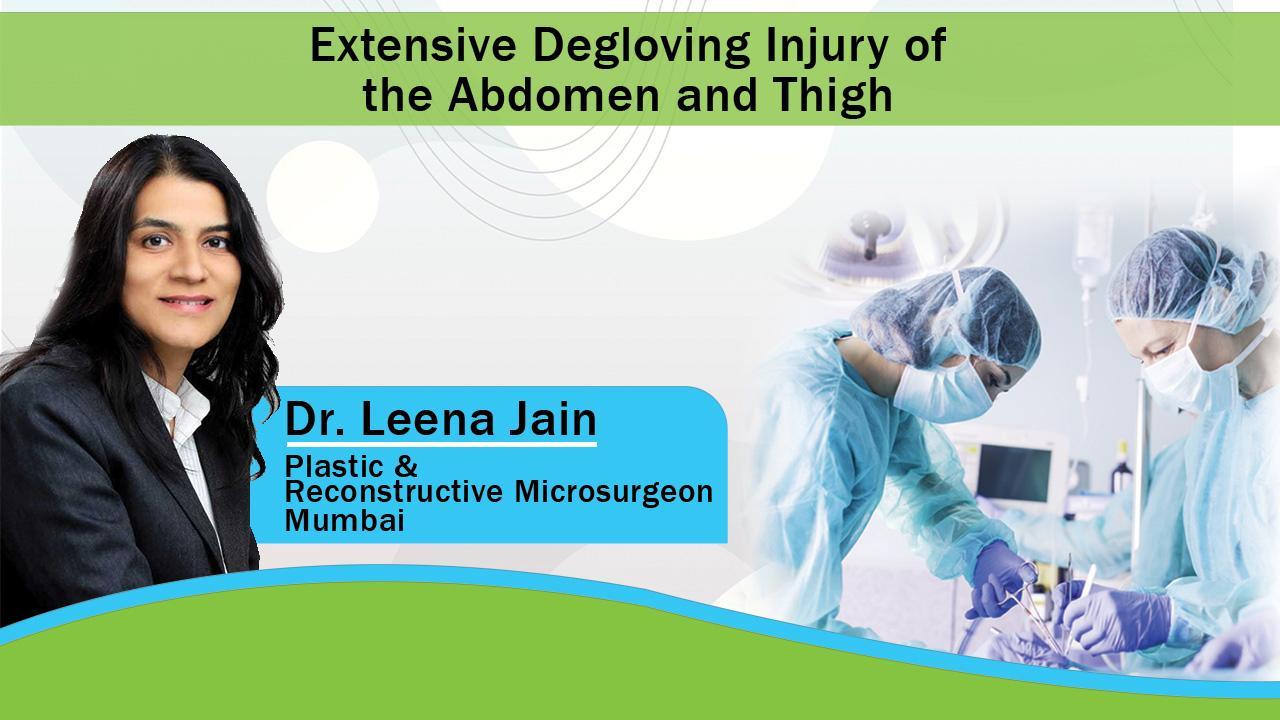Mumbai's Dr. Leena Jain, has successfully treated a case of Extensive Degloving Injury of the Abdomen and Thigh in a young male patient.

Dr. Leena Jain
Degloving injuries of the abdominal wall are rare compared with those of extremities. In the latter, bone provides a solid counteractive force, while in the former, degloving occurs against the musculo-aponeurotic layer, a tough structure comparable to bone(1).The toughness of this same layer usually protects the viscera and solid organs in such injuries .
ADVERTISEMENT
Dr. Leena Jain, Plastic Surgeon in Mumbai states, 'Degloving injuries are very critical to treat while outcomes depend upon the extent of injury, but the recovery process is a lengthy one and involves a multidisciplinary approach towards for best recovery outcomes.
There were neither any visceral injury nor any long bone fractures. There was a distal penile urethral tear. On arrival, supportive management was started. He was taken for a pulse lavage of the wounds and extent of degloving was evaluated. The degloving in the abdominal wall was through a plane below the anterior rectus sheath, so the entire aponeurotic layer along with skin and subcutaneous tissue were lost; hwoever the rectus abdominis muscle was intact completely. Degloving extended from just below the umbilicus to just below the left inguinal region and on the right side it extended along the inguinal ligament, anterior thigh upto just above the knee joint. Transversely it extended from right ASIS to left ASIS and medial to lateral thigh border. Right iliac crest was exposed from anterior superior iliac spine to laterally for about 3-4 cms. The right femoral triangle was deroofed hence, femoral neurovascular bundle lay exposed. In the midline phallus and scrotum were degloved till base of scrotum resulting in exposure of both testes. There was extensive contamination in between all muscle planes with gravel and sand. There was necrosis of entire right sartorius, rectus femoris, vastus lateralis, and parts of vastus medialis. A thorough debridement was done. Gracilis muscle flap was used to cover the femoral triangle Tracheostomy was done in view of repeated surgeries and a relook debridement done 48 hours later with left orchidectomy in view of degloving and ischemia. Distal half of gracilis was dead and hence debrided, with sparingly less cover on femoral artery. Negative pressure wound dressing was then applied. Subsequently all wounds were covered with cadaveric human skin as skin is the best biological dressing. However, a check dressing three days later revealed loss of almost entire homograft. Patient had a few temperature spikes and antibiotics were stepped up as per culture reports which had grown Klebsiella. The wound continued to look unhealthy till about 4th NPWT dressing change and then it started improving. NPWT was continued for two more weeks and partly exposed femoral artery and iliac crest also were covered with healthy granulation (figure 2). For a definitve cover, once the wounds were well granulated, split skin graft was harvested from his left thigh and leg using an electric dermatome. The grafts were expanded using a mesher to1.5times, anchored on the wounds with staples and immobilised using NPWT. Graft take up was about 92-95 % residual scattered raw areas started healing with dressings. Definitive urethral repair was planned secondarily.
He was then rehabilitated with physiotherapy, decannulation and high protein diet. Two months after discharge, his grafts and donor sites are supple and well healed. He can walk for about 4-5kms continuously. For his extensor lag, he is on quadriceps strengthening exercises.
Discussion
Extensive degloving injury can induce septicaemia in view of contamination, devitalisation of tissues, haematoma and progressive catabolism. The outcome of these injuries depends on extent of acute haemorrhage, haemodynamic instability, hypoproteinaemia, complications of massive transfusion, heavy contamination of wounds, sepsis, ARDS and MODS(3).
After initial stabilization, repeated debridements to reduce colonization are the key in prevention of septicaemia.
At primary presentation, harvesting skin graft from the degloved abdominal/ thigh flap is an invaluable therapeutic option to cover the extensive wound before inflammation sets in. This spare part surgery reduces blood loss, chances of infection and need for extensive grafts in the setting of limited donor site availability, secondary intention wound healing and scar formation which decreases skin plasticity. It promotes faster wound healing and rehabilitation. Homografts from skin banks are quite helpful in such settings till wounds start showing signs of healing and grafting can be planned. Due to the extensive area of degloving, local/distant flaps were not an option.
When the patient presents later where the golden period is lost, negative pressure wound therapy plays an essential role for an optimal outcome.
Conclusion
A multidisciplinary approach is essential in the management of such devastating injuries. Debridements, NPWT and skin grafting are the key players to ensure a successful outcome.
Dr. Leena Jain is an expert Reconstructive Microsurgeon with experience in treating Tumors, trauma, burns, and congenital conditions. She has also performed replantations and revascularizations for total to near-total amputations of upper or lower limb at various levels, reconstruction surgeries for orthopedic trauma including flap cover surgeryes, tendon repair and management of small and long bone non-unions, and so on.
Dr. Leena Jain is available for consultation at Lilavati Hospital & Research Centre, Bandra and her private clinic at Borivali, Mumbai. Call on +91 98209 91853 or email at link.jain@gmail.com for appointments.
 Subscribe today by clicking the link and stay updated with the latest news!" Click here!
Subscribe today by clicking the link and stay updated with the latest news!" Click here!







